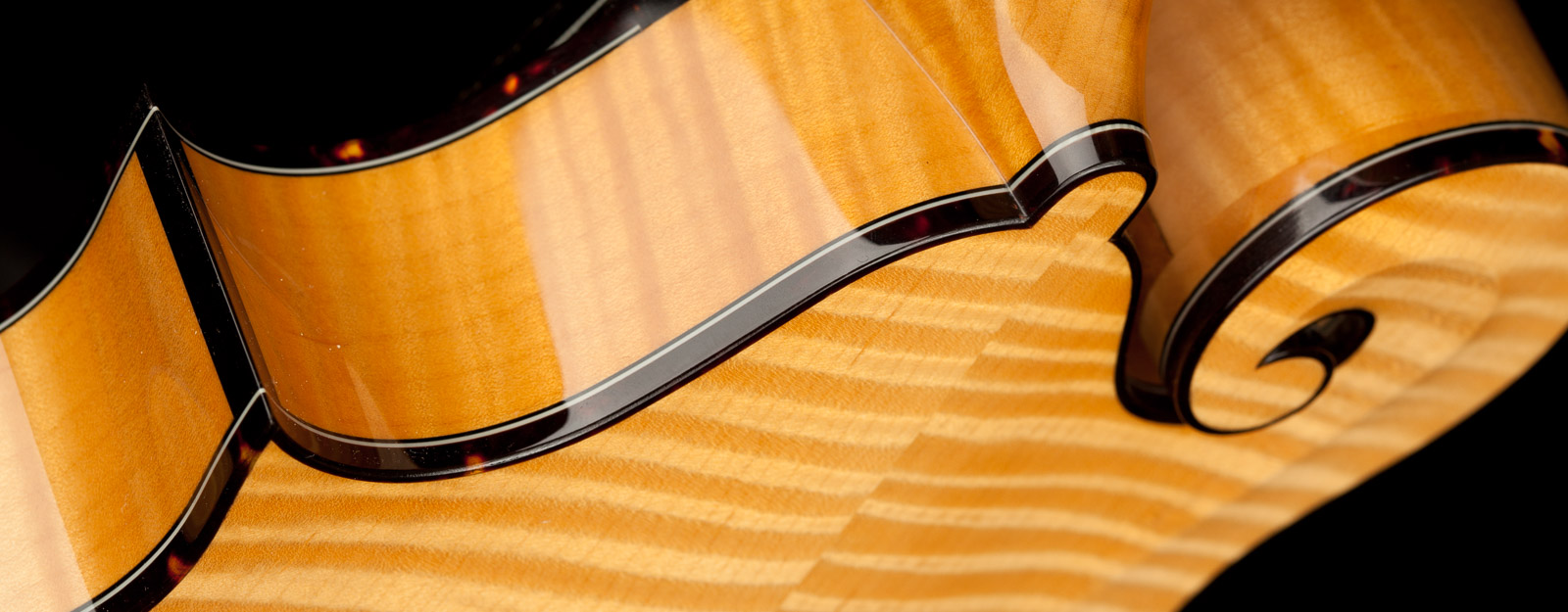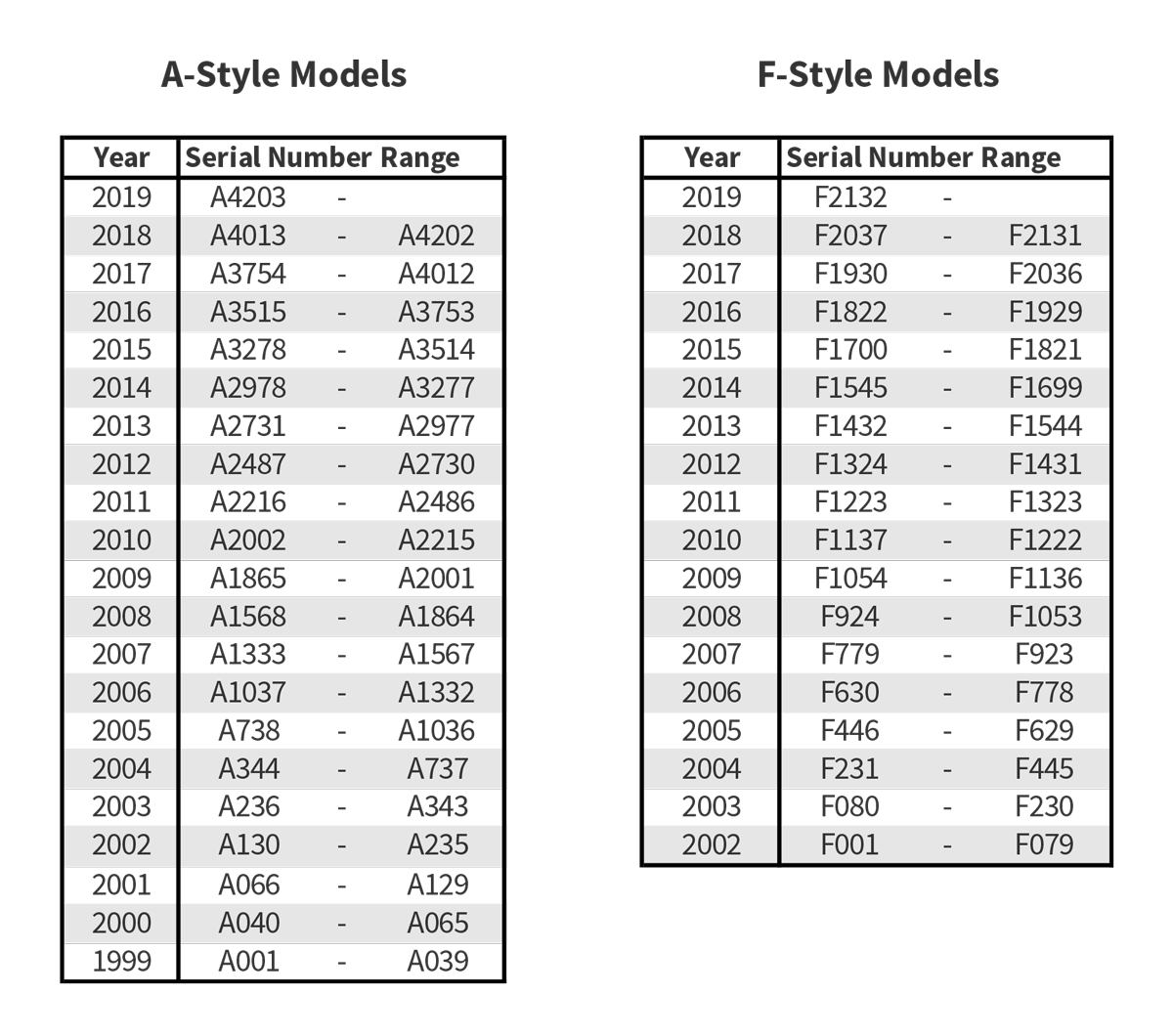FAQ Topics

Mandolins
Custom Orders
Care & Maintenance
Setup
Pickups
Finish Options
Serial Numbers & Dating
Warranty & Registration
Parts & Repair
Custom Orders
How long does it take to place a special order?
The lead time for new orders can vary depending on the model and the existing backlog of orders. Most lacquer finish models can be delivered within 3-4 months. Varnish instruments may take 4-6 months. If you are considering placing a custom order, your dealer will be able to provide you with a price quote and time estimate for delivery. All custom orders must be placed through an authorized Collings dealer.
Care & Maintenance
How can I tell if my mandolin needs to be humidified?
Our mandolins are built in a controlled environment with constant 49% relative humidity. In order to keep your instrument in proper playing condition and prevent cracking or other structural problems, it is very important that you maintain a similar level of humidity where you store your instrument. In many climates, it can be difficult to achieve an adequate humidity level without help from a sound hole humidifier. We strongly recommend investing in an inexpensive hygrometer to monitor the environment where you store your instrument. A hygrometer can help you gauge whether your instrument is in danger of becoming dried out or over-hydrated. We also recommend familiarizing yourself with the symptoms of a dry instrument, so you can identify potential problems before they cause any real damage. This is an extremely important topic, so please visit our Care and Maintenace page for additional information.
What type of humidifier do you recommend?
There are a wide variety of products out there that can help you keep your instrument properly humidified (see Care and Maintenance). The most common humidifier used for mandolins is a DAMPIT. It's also a good idea to invest in an inexpensive hygrometer to help you monitor the environment where you store the instrument. A hygrometer will help take the guess-work out of knowing when and when not to humidify. Keep in mind that it is possible to over-humidify your instrument, which can also lead to problems.
How can I prevent my instrument from developing cracks?
The overwhelming majority of cracks are caused by inadequate humidity. Exposing your instrument to a low humidity environment can cause the woods to contract and change shape, which can lead to cracking and a host of other structural and finish problems. It's important to be aware of the humidity where you store your mandolin. If you find that your instrument is being exposed to conditions with less than 40% relative humidity for any length of time, you should consider humidifying. In very dry conditions, a mandolin can dry out to the point of cracking in a matter of days. This is an extremely important topic, so please visit our Care and Maintenance page for more information.
Setup
What type of strings do you use?
All of our mandolin models are strung with D'Addario EJ74 (.011", .015", .026", .040") phosphor bronze strings. It's also perfectly fine to use heavier gauge strings such as the D'Addario EJ75 set without harming the instrument.
Necks
What are my options for neck profiles?
All of our f-hole instruments have a 1 1/8" nut width as a standard. We also offer a 1 3/16" nut option, which allows for a more rounded neck shape. The standard nut width is the most popular choice, although the wider nut width may be a better fit for players with larger hands or those who prefer necks with less "V" shape. All oval hole models come standard with the wider 1 3/16" nut width. If you have a specific neck profile request, please let your dealer know and we'll do our best to accommodate.
What type of fret wire do you use?
Our standard fretwire dimensions are as follows:
crown width: 2 mm
crown height: 1.10 mm
Total height 2.60 mm
Tang width: 0.51 mm
Where do you recommend installing a strap button on my mandolin?
The recommended location for installing a strap button is on the underside of neck 3/4” below the bottom of the fingerboard and 1/2” over from the body. We recommend clipping 1/8” off the end of the screw to avoid running into the truss rod. The screw hole should be drilled at an angle, perpendicular to the surface of the wood, and a felt bushing may be used between the strap button and the wood's surface to avoid unnecessary imprinting.
Pickups
What type of mandolin pickup to you recommend?
We generally recommend either the K&K Mandolin Twin or the McIntyre MF-200 Feather System as good options for most applications. These systems consist of transducer strip(s) that mounts to the inside of the top, which can be wired to either a standard end pin jack or an external carpenter-style jack. With either pickup system, a high quality pre-amp such as the L.R. Baggs Para Acoustic D.I. is essential for optimum tone.
Finish Options
How does a lacquer finish compare to a varnish finish?
Varnish is a softer and therefore more flexible finish material. While there are subtle tonal advantages to the varnish finish, this option is not for everyone. Unlike lacquer, the process for applying varnish is not conducive to "finish touch-ups", meaning that we cannot repair some minor imperfections such as small pinholes, bubbles, or sinks. While we've always taken pride in our high standard for fit and finish, we cannot produce varnish instruments to the level of cosmetic "perfection" as we can with our lacquer finish instruments. The varnish finish has a beautiful, rich luster, but may include very small imperfections when put under close examination.
Additionally, the softer varnish finish is not quite as protective as the harder lacquer finish. The alkyd resin-based varnish finish is very slow to cure and can be relatively soft on new instruments. The finish will continue to harden as the instrument ages, but new varnish instruments can be vulnerable to scratches, dings, and imprinting. By its very nature, varnish can shrink, wrinkle, and/or dull over time and is not likely to maintain a "new" apperance as well as lacquer instruments. With that said, the varnish finish allows the instrument to vibrate more freely and can produce a more responsive instrument with a greater depth of tone.
Serial Numbers & Dating
Where can I find my mandolin's serial number?
Serial numbers are printed on the Collings label inside the instrument, which can be seen through the bass-side f-hole or oval sound hole.
How can I determine the age of a particular mandolin or mandola?
Collings mandolins have a hand-written serial number on the label inside the body. The table below lists serial number ranges issued into production by year. Serial numbers are assigned at the beginning of the build process, so some mandolins would have been completed and shipped in subsequent year(s). Most mandolins spend 3-6 months in production, but build time can vary from instrument to instrument.

Warranty & Registration
What is covered under my instrument's warranty?
Collings instruments are warranted to be free from defects in materials and workmanship, to the original purchaser, for as long as he/she owns the instrument. This limited warranty constitutes the entire warranty of Collings with regards to its instruments. No representation or warranty by any Collings salesperson, dealer, agent, representative or employee shall be binding upon Collings Guitars, Inc. other than as expressly set forth herein.
The Collings Limited Warranty does not cover the following: wear and tear from normal use and any damage that is the result of misuse, abuse, or unauthorized modifications, damages from unauthorized or self-made repairs, improper maintenance, accidents, exposure to adverse temperature and/or humidity, and other careless action, which by its nature results in damage to the instrument or to components not manufactured by Collings.
Parts & Repair
I would like to have a pickguard installed on my mandolin. How can I go about this?
NOTE: Due to resource constraints, we currently have a hold on all parts orders, including mandolin pickguards.
We install aftermarket pickguards on Collings mandolins at our shop for $250 (unbound) or $400 (bound). Our pickguards are designed to be attached using threaded inserts that are installed into the fingerboard extension, which allows the pickguard to be easily removed/replaced. Since the installation procedure can be tricky and requires a specially made fixture, we require that the mandolin be sent in to our shop for installation. We do not sell pickguards separately, unfortunately.
My instrument is in need of repair. Where can I take it for service?
Your local Collings dealer is usually the best place to start. Many repair issues can be resolved by simple adjustments to the nut, bridge, or truss rod. Your dealer can most often help in this area and can also rule out the causes of common problems. Alternatively, we offer warranty repair services at our shop. Your dealer can usually assist you in packaging and shipping your mandolin to our shop if needed. Please visit our repairs page for more detailed information.